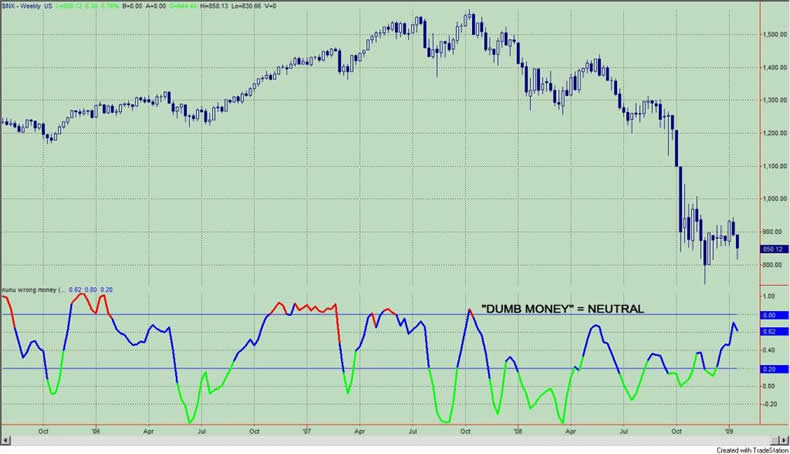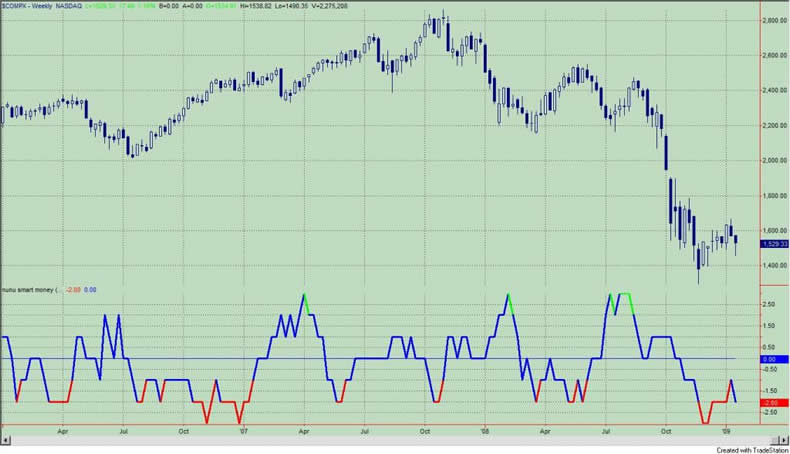Stock Market Investor Sentiment Indicator Remains at Neutral
Stock-Markets / Trader Psychology Jan 20, 2009 - 01:45 AM GMTBy: Guy_Lerner

 The "dumb money" sentiment indicator remains neutral on the equity markets, and the "smart money" has turned more bearish. It should be noted that this is the sixth week in a row where the "dumb money" is neutral, and this is not a scenario that is generally supportive of higher prices especially with prices on the S&P500 under their 40 week moving average. The ideal situation for higher equity prices would be for the "smart money" to be bullish and the "dumb money" bearish (i.e., bull signal).
The "dumb money" sentiment indicator remains neutral on the equity markets, and the "smart money" has turned more bearish. It should be noted that this is the sixth week in a row where the "dumb money" is neutral, and this is not a scenario that is generally supportive of higher prices especially with prices on the S&P500 under their 40 week moving average. The ideal situation for higher equity prices would be for the "smart money" to be bullish and the "dumb money" bearish (i.e., bull signal).
The "dumb money" or investment sentiment composite indicator (see figure 1, a weekly chart of the S&P500) looks for extremes in the data from 4 different groups of investors who historically have been wrong on the market: 1) Investor Intelligence; 2) Market Vane; 3) American Association of Individual Investors; and 4) the put call ratio.
Figure 1. "Dumb Money"

The "smart money" (see figure 2) refers to those investors and traders who make their living in the markets. Supposedly they are in the know, and we should follow their every move. The "smart money" indicator is a composite of the following data: 1) public to specialist short ratio; 2) specialist short to total short ratio; 3) SP100 option traders.
Figure 2. "Smart Money"

For the past 3 weeks it has been the same story: sell hope and buy fear. If the "dumb money" indicator is any gauge, it appears that market participants are caught on the wrong side of the trend. This week the bulls remain hopeful of a post inaugural rally, but even if it does materialize, the correct course of action for those with a trading mindset is to sell strength. I define what I mean by "strength" in the article, "Investor Sentiment: Some Context".
From my perspective, it is likely that the November, 2008 lows will be tested and possibly violated. This is another way of saying, "we need more bears" before the market can go higher, and this means the "dumb money" indicator needs to turn bearish (i.e., bull signal) before a multi week trade is likely to develop.
Finally, it should be noted that the "smart money" has been bearish for 8 out of the last 9 weeks. In 18 years of data and in over 45 signals, the "smart money" has confirmed the "dumb money"in over 95% of the cases. By this I mean, we need to see the "smart money" turn bullish as a confirmation of the “dumb money” turning bearish. Typically, lower prices will make the “smart money” turn bullish.
By Guy Lerner
http://thetechnicaltakedotcom.blogspot.com/
Guy M. Lerner, MD is the founder of ARL Advisers, LLC and managing partner of ARL Investment Partners, L.P. Dr. Lerner utilizes a research driven approach to determine those factors which lead to sustainable moves in the markets. He has developed many proprietary tools and trading models in his quest to outperform. Over the past four years, Lerner has shared his innovative approach with the readers of RealMoney.com and TheStreet.com as a featured columnist. He has been a regular guest on the Money Man Radio Show, DEX-TV, routinely published in the some of the most widely-read financial publications and has been a marquee speaker at financial seminars around the world.
© 2009 Copyright Guy Lerner - All Rights Reserved
Disclaimer: The above is a matter of opinion provided for general information purposes only and is not intended as investment advice. Information and analysis above are derived from sources and utilising methods believed to be reliable, but we cannot accept responsibility for any losses you may incur as a result of this analysis. Individuals should consult with their personal financial advisors.
Guy Lerner Archive |
© 2005-2022 http://www.MarketOracle.co.uk - The Market Oracle is a FREE Daily Financial Markets Analysis & Forecasting online publication.


